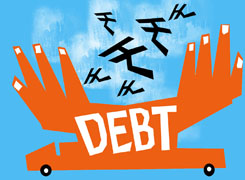Ramalingam Kalirajan |10925 Answers |Ask -Follow
Mutual Funds, Financial Planning Expert - Answered on May 26, 2024
He has an MBA in finance from the University of Madras and is a certified financial planner.
He is the director and chief financial planner at Holistic Investment, a Chennai-based firm that offers financial planning and wealth management advice.... more

I am in deep debt about ten crores. My business right now has a topline of one cr with 30% gross margins. I have lost hopes of living... Please help. How can i come out of this mess?
Understanding Your Current Situation
Business Overview
Your business has a topline of Rs. 1 crore with a 30% gross margin. This means you have a gross profit of Rs. 30 lakhs annually. While this is a positive aspect, it may not be sufficient to service a debt of Rs. 10 crores.
Debt Details
A debt of Rs. 10 crores is substantial. Understanding the nature of this debt (secured, unsecured, interest rates, repayment terms) is crucial for creating a repayment strategy.
Immediate Steps to Manage Debt
Prioritize Debt Payments
Identify and prioritize debts based on interest rates and repayment terms. Focus on high-interest debt first to reduce the overall interest burden.
Negotiate with Creditors
Open communication with your creditors can lead to better repayment terms. Creditors might be willing to restructure your debt, offer lower interest rates, or extend repayment periods.
Expense Management
Review and cut non-essential expenses. Every rupee saved can help in debt repayment. Streamline operations to reduce costs without compromising business quality.
Increasing Business Revenue
Boost Sales
Focus on strategies to increase sales. Enhance marketing efforts, explore new markets, or introduce new products or services to attract more customers.
Improve Profit Margins
Find ways to improve your profit margins. Negotiate better terms with suppliers, reduce waste, and improve operational efficiency.
Diversify Income Streams
Consider diversifying your income streams. Look for additional revenue opportunities within your industry or related fields.
Financial Planning and Budgeting
Create a Budget
Develop a detailed budget outlining your income, expenses, and debt repayments. Stick to this budget to ensure you are on track with your financial goals.
Emergency Fund
Although debt repayment is a priority, maintaining a small emergency fund is essential. This prevents additional debt in case of unexpected expenses.
Professional Guidance
Certified Financial Planner (CFP)
Engage a CFP for personalized financial advice. A CFP can help you create a comprehensive debt repayment and financial recovery plan tailored to your situation.
Debt Counseling
Consider professional debt counseling services. They provide advice on managing debt, negotiating with creditors, and creating repayment plans.
Long-term Strategies for Financial Stability
Increase Capital Efficiency
Use your existing capital more efficiently. Reinvest profits back into the business to spur growth and improve financial health.
Seek Additional Funding
Explore funding options such as business loans, grants, or investors. Ensure that any additional funding obtained is used strategically to improve business profitability.
Asset Liquidation
If you have non-essential assets, consider liquidating them to reduce debt. This can provide immediate cash flow to address pressing financial obligations.
Mental Health and Emotional Support
Seek Support
Dealing with financial stress can be overwhelming. Seek support from friends, family, or professional counselors. Emotional and mental health is crucial during challenging times.
Stay Positive
Maintain a positive outlook. Financial difficulties can be temporary. With a structured plan and consistent effort, you can overcome these challenges.
Practical Steps for Implementation
Monthly Review
Conduct monthly reviews of your financial situation. Assess your progress in debt repayment, business performance, and adherence to the budget.
Adjust Strategies
Be flexible and willing to adjust your strategies as needed. Monitor market trends, business performance, and financial health regularly.
Document Progress
Keep detailed records of your financial transactions, debt repayments, and business growth. This documentation helps in tracking progress and making informed decisions.
Building a Financial Cushion
Savings Plan
Once the immediate debt pressure eases, start building a financial cushion. Regular savings can provide security and buffer against future financial challenges.
Investment Strategy
Develop a long-term investment strategy. Investing in diversified portfolios can help grow your wealth and provide financial stability.
Conclusion
Overcoming a Rs. 10 crore debt with a Rs. 1 crore business turnover is challenging but achievable. Focus on increasing revenue, improving profit margins, and negotiating with creditors. A Certified Financial Planner can provide the professional guidance needed to create and implement an effective plan.
Stay committed to your financial goals, remain positive, and seek support when needed. With persistence and strategic planning, you can navigate through this challenging phase and achieve financial stability.
Best Regards,
K. Ramalingam, MBA, CFP,
Chief Financial Planner,
www.holisticinvestment.in
You may like to see similar questions and answers below
Ramalingam Kalirajan |10925 Answers |Ask -Follow
Mutual Funds, Financial Planning Expert - Answered on Apr 15, 2024
Ramalingam Kalirajan |10925 Answers |Ask -Follow
Mutual Funds, Financial Planning Expert - Answered on May 04, 2024
Ramalingam Kalirajan |10925 Answers |Ask -Follow
Mutual Funds, Financial Planning Expert - Answered on Jun 19, 2024
Samraat Jadhav |2523 Answers |Ask -Follow
Stock Market Expert - Answered on Aug 19, 2024
Naveenn Kummar |238 Answers |Ask -Follow
Financial Planner, MF, Insurance Expert - Answered on Sep 11, 2025
Reetika Sharma |459 Answers |Ask -Follow
Financial Planner, MF and Insurance Expert - Answered on Dec 24, 2025
Reetika Sharma |459 Answers |Ask -Follow
Financial Planner, MF and Insurance Expert - Answered on Dec 24, 2025
Reetika Sharma |459 Answers |Ask -Follow
Financial Planner, MF and Insurance Expert - Answered on Dec 24, 2025
Reetika Sharma |459 Answers |Ask -Follow
Financial Planner, MF and Insurance Expert - Answered on Dec 24, 2025
Reetika Sharma |459 Answers |Ask -Follow
Financial Planner, MF and Insurance Expert - Answered on Dec 24, 2025
Reetika Sharma |459 Answers |Ask -Follow
Financial Planner, MF and Insurance Expert - Answered on Dec 24, 2025
Reetika Sharma |459 Answers |Ask -Follow
Financial Planner, MF and Insurance Expert - Answered on Dec 24, 2025
Reetika Sharma |459 Answers |Ask -Follow
Financial Planner, MF and Insurance Expert - Answered on Dec 24, 2025
Reetika Sharma |459 Answers |Ask -Follow
Financial Planner, MF and Insurance Expert - Answered on Dec 24, 2025
Reetika Sharma |459 Answers |Ask -Follow
Financial Planner, MF and Insurance Expert - Answered on Dec 24, 2025
























